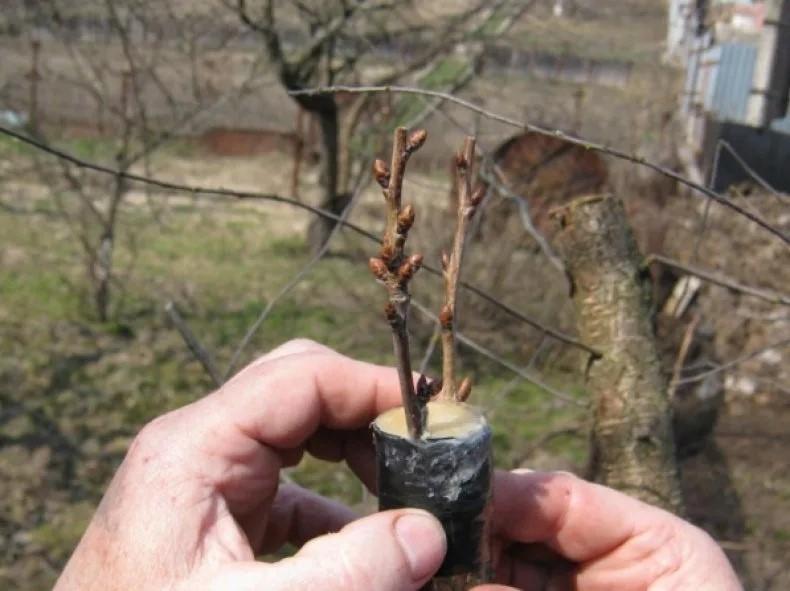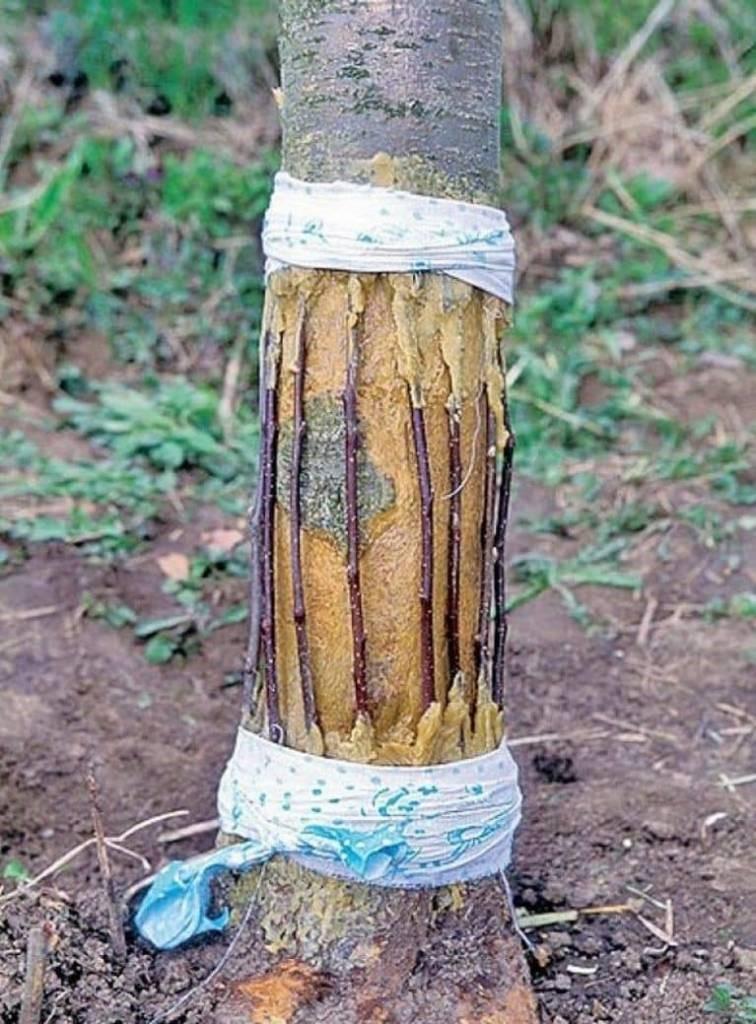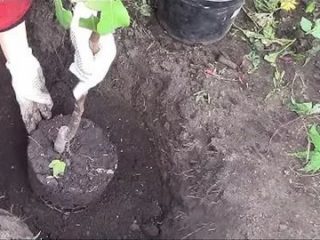Content
When the need arises to graft a pear onto an apple tree in the spring, beginners do not know how to do it better. But sometimes this is the only method to save a culture from destruction. When propagated vegetatively, the tree becomes a good replacement.
Is it possible to graft a pear onto an apple tree?
It is possible to graft a pear onto an apple tree, and in some cases it is even necessary. Knowledge of the procedure will broaden the gardener’s horizons: he will get acquainted with fruit crops, understand the peculiarities of metabolic processes, learn how to care for trees and restore them in case of illness.
Advantages and disadvantages
Correctly carried out grafting allows you to propagate the desired variety, increase its frost resistance and productivity.

After grafting, the plant’s immune system becomes stronger
Other advantages include:
- saving space on the site;
- improving the taste of fruits;
- preservation of the tree in case of damage;
- change or extension of harvest dates;
- turning a wild animal into a cultivated plant;
The method has one drawback: with the wrong technology, you can lose both plants. Therefore, it makes sense to analyze all the nuances in detail.
When can you graft a pear onto an apple tree?
Since vital processes constantly support the pear, vaccination can be done at any season. However, there are periods when it is better not to do this. In winter, the operation is not always successful; the probability is close to 5-10%. Therefore, gardeners recommend carrying out work during the warm season.
in spring
You can graft a pear onto an apple tree in the spring step by step according to the instructions. Even a beginner can handle this.

The probability of a favorable outcome is 95%, which is an undoubted advantage of the method
Grafting is carried out before the buds begin to swell, when the movement of juice is weakened. The second important factor is the absence of night frosts. The thermometer should not show negative temperatures.
In summer
You can graft a pear onto an apple tree later in the summer. July is ideal for this. To exclude the influence of ultraviolet radiation, the grafting site is shaded. Otherwise, the tree may dry out.

Some people propagate pears in August, but the likelihood of adaptation is reduced.
in autumn
Botanists do not recommend grafting a pear onto an apple tree in the autumn. This is due to the preparation of the plant for the cold. Nutrients rush to the roots, reducing the efficiency of restoration processes. The likelihood of successful grafting is also reduced by precipitation.

It often rains in autumn and gets cold at night, which creates stress
How to properly graft a pear onto an apple tree
To carry out vaccination prepare:
- garden var;
- sharp knife;
- several rags;
- electrical tape;
- hacksaw;
- scissors.
The sharper the tool, the faster the pear will recover after grafting to the apple tree. Before work, he is sterilized to prevent infection. Use alcohol or any disinfectant.
Grafting pruner
Garden shears have a universal purpose. With their help, a neat cut is made between the scion and the rootstock. The tool has several blades, allowing you to graft as accurately as possible.
If you have pruning shears, vaccination takes place in a simplified mode. Reproduction is carried out quickly and painlessly, which is very important for the condition of the plants.

A gardener can carry out several operations in one day
Grafting with pruning shears also has its downsides. For example, the tool is designed for identical thickness of shoots, which limits the choice of material. Due to the tight closure, the recovery process slows down. In addition, pruning shears are difficult to treat with sterilizing agents, increasing the chance of infection.
Budding
You can graft a pear onto an apple tree using cuttings through budding. Use fresh material. The best time to carry out work is mid-July. The deadline will be the first days of August.
Grafting is carried out using two methods - dormant and germinating eyes. In the first case, the bud must germinate. Speed is very important, since the peephole will not have time to adapt due to weak sap flow.
The rootstock is moistened a week before surgery. Watering is carried out in the evening and in the morning, when dry weather has settled. This is necessary for the waste of the apple tree bark. Using a wet rag, remove dirt from the tree. They retreat 6 cm from the ground and make a cut in the shape of the letter “T”.
The pear stalk is cleared of green matter. The material should not be damaged in this case. For grafting, one healthy bud is found and cut off with a cutting instrument along with the bark and cambium.
Using a tool, the bark of the apple tree is pulled back, exposing the cut. A pear bud with the bark cut out is inserted into it. The wood is securely fixed with polyethylene.

After two weeks, the petiole will fall off on its own and green pear tissue will appear.
By September-October, the buds are pinched out. By then, the first four leaves will have formed.
Vaccination for bark
The optimal period is the end of spring. During this period, active movement of the juice liquid occurs, which allows the bark of the apple tree to be easily separated.
To do this, cut with a hacksaw. When there is no suitable tool, they use a sharp knife. The thickness of the rootstock is made around 3-5 cm. If the trunk is large, you can graft two cuttings. On the bark of the apple tree, a cut is made in the vertical direction of 35 mm. The wood is bent and an incision is made on the pear. It should have four viable buds.
The cutting is placed in the center of the cut, covering the core. At the same time, a 2 mm part of it is left open so that the tree can form callus.

The grafting areas are treated with garden varnish and wrapped with cloth or tape.
If the apple tree is much larger than the pear, the operation is carried out on the thorny bark. An incision is made on the cutting, pushing the bark back to the wood. Another cut with a ledge is made on the branch and fixed with cloth.
Copulation
The grafting is carried out with shoots that have more than three developed buds. The optimal time is spring, but it is also possible in summer. Take cuttings of the same size. They make cuts at an acute angle.

The pear is pressed tightly against the apple tree so that their tissues converge
After grafting, they are treated with varnish and tied.
Improved copulation
To graft a pear onto an apple tree in the spring, use a fresh scion. Improved copulation involves vegetative propagation, in which the cuttings perfectly match each other. Raw materials are harvested in autumn or spring. For storage, use a room with a temperature slightly above 0 °C.

The cuts are made oblique, together with them the tongue is cut in the opposite direction
The thickness of the tongue is formed from 2 to 2.5 mm. Cut it so that it is in the same plane. When applied, the apple and pear should match. After joining, two buds are left on the shoot, treated with varnish, and tied.
Into the cleft
One of the simplest methods of crossing an apple tree with a pear tree, since any raw material in size is suitable for this. Work is carried out in early spring or April. At the same time, the kidneys are just beginning to increase their mass.
The apple tree is prepared as follows: it is cleared of soil and old bark, the tree that is 10 cm above the soil level is cut off. After this, the wood is cleaned with a knife. The rootstock is pruned to three pear diameters. A wedge is inserted into the resulting gap. It is pre-treated with a disinfectant.
The pear is prepared as follows: a viable shoot with four buds is found and a cut is made. After stripping, the material is inserted into the gap of the apple tree. The cambium of the two breeds should fit tightly.

Free space is left above the lumen to accelerate recovery processes
Open areas are covered with varnish. The graft is secured with any available material - fabric, tape or film.
Side cut
When a one-sided crown is formed, grafting is carried out in a side incision. Apple and pear trees quickly grow together, forming a strong plant. The procedure is carried out in spring or mid-summer. A few buds are left on the cuttings of the apple tree, then a cut is made at an angle of 30 degrees. Its size is selected according to three diameters. The cutting tool is brought to the shoot axis at an angle of 90 degrees.
When turning the shoot back, the position of the knife is changed by 40 degrees, forming a second cut. It should match the notch in the pear. The instrument is inserted into the cortex at an angle of 20 degrees. In this case, the depth of the cut on the apple tree will coincide with the cut on the pear.

Plants are connected by moving the cambium layer to the side
Next, wrap it with electrical tape and sterilize it with garden varnish.
By the bridge
If the trunk is deformed, grafting is done with a bridge. The peculiarity of the method is that it is often carried out in winter. By this period, rodents cause serious damage to the pear.The grafting is carried out in the middle part of the bark, dividing it with several cuttings. The damaged area is leveled and cleaned to a healthy surface.
The buds are removed from the shoots, and holes are made at an acute angle towards the end. The treated branches are inserted in both parts into recesses in the bark. A small distance is left above and below from the deformed area. The cortex with the bridge is fixed in a similar way. An arch is formed, which is wrapped with electrical tape for reliability.

As in previous cases, open areas are covered with varnish.
Advice! Instead of garden composition, you can use moss.
Grafting on a columnar apple tree
If an apple tree is injured, it can be restored with a shoot from another tree, for example, a pear. The fracture site will recover with the support of a healthy plant. The columnar apple tree does not require formative pruning and produces a stable and sweet harvest. These varieties include dwarf trees.

Vaccination is carried out if the crop cannot cope with the damage on its own.
The operation is highly likely to be successful. The crown retains a neat appearance, the harvest remains the same.
Grafting on a wild apple tree
Vaccination is carried out in order to increase the immunity of garden crops, since wild species are more adapted to external factors. An apple tree can be easily grown from a seed or a shoot can be dug up in the forest.

If the tree produces few fruits, grafting onto wildflowers will be the best solution.
A self-grown tree has weak cuttings. They need care before and after vaccination. The owner will have to monitor the temperature and precipitation. If the procedure is carried out in the fall, the plant is covered.
After crossing, the taste of the fruit does not change significantly, and the number of fruits may fall below average. It depends on the specific case. Sometimes a wild plant cannot cope with winters and dies in the same year.
Conclusion
You can graft a pear onto an apple tree in the spring using different methods; depending on your preferences and expectations, you choose one or the other. The methods have nuances that a beginner should pay special attention to. The best time for vaccination is spring. However, there are masters who successfully cross apple and pear trees in summer, autumn and even winter.








